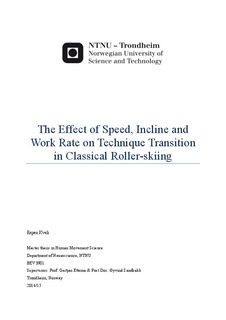| dc.description.abstract | Purpose: Cross-country skiers use three main classical sub-techniques to adapt to varying
speed and incline during training and competition in order to ski as efficient as possible. The three main sub-techniques are diagonal stride (DIA), double poling with a kick (DK) and double poling (DP). The present study investigated the number and moment of occurrence for technique transitions at constant work rates with varying speed and incline combinations, as well as the effect of work rate in classical roller-skiing. Additionally, the total time distribution of the various sub-techniques was examined.
Methods: Eight male national level skiers (age 22.4 ± 1.7 years, body height 183.7 ± 4.4 cm, body mass 80.3 ± 7.7 kg and VO2-max 73.9 ± 6.4 ml·kg-1·min-1) performed three test sessions of 23 minutes at respectively low-, moderate-, and high intensity while roller-skiing on a large treadmill. The protocols consisted of two main parts; I) 3 to 11%, with incremental increase of 1% each minute and II) 11 to 3% with incremental decrease of 1% each minute. Part I and II was separated by a 1-minute brake for lactate sample. Speed at every incline was calculated to keep a constant work rate. Physiological recordings (oxygen uptake and heart rate) and 3-D kinematics were synchronized and continuously recorded.
Results: Physiological values were different between low-, moderate- and high intensity
(oxygen uptake 39.3 ± 1.2, 45.2 ± 1.2 and 52.0 ± 1.4 ml·kg-1·min-1, heart rate; 138 ± 12, 148 ± 8 and 166 ± 10 bpm (all P < 0.01). Total number of technique transitions for all subjects during the whole 23-minutes protocols showed a significantly decrease from moderate- (66) to high (45) intensity (P = 0.04). Moment of occurrence for technique transitions did not differ between low-, moderate- and high intensity (6 ± 1.2, 6 ± 0.8 and 6 ± 0.8% incline) for the transition from DK to DP. Speed values for DK to DP technique transition were respectively 9.8 ± 1.4, 11.6 ± 1.1 and 13.1 ± 1.3 km·h-1. Total time distribution of DK increased significant from 282 ± 74 seconds at low- to 352 ± 108 seconds at high intensity (P = 0.01), whilst the moderate intensity did not differ from the two other work rates.
Conclusions: The current study indicates that incline rather than speed was the determining factor regarding technique transitions in the classical roller skiing technique. The highest work rate had significantly less technique transitions compared to the moderate intensity, but there were no linear trend in number of technique transitions with increasing intensity. The total time spent in DK showed a linear increase with increasing work rate, and was significantly higher at high- compared to low intensity. | nb_NO |
